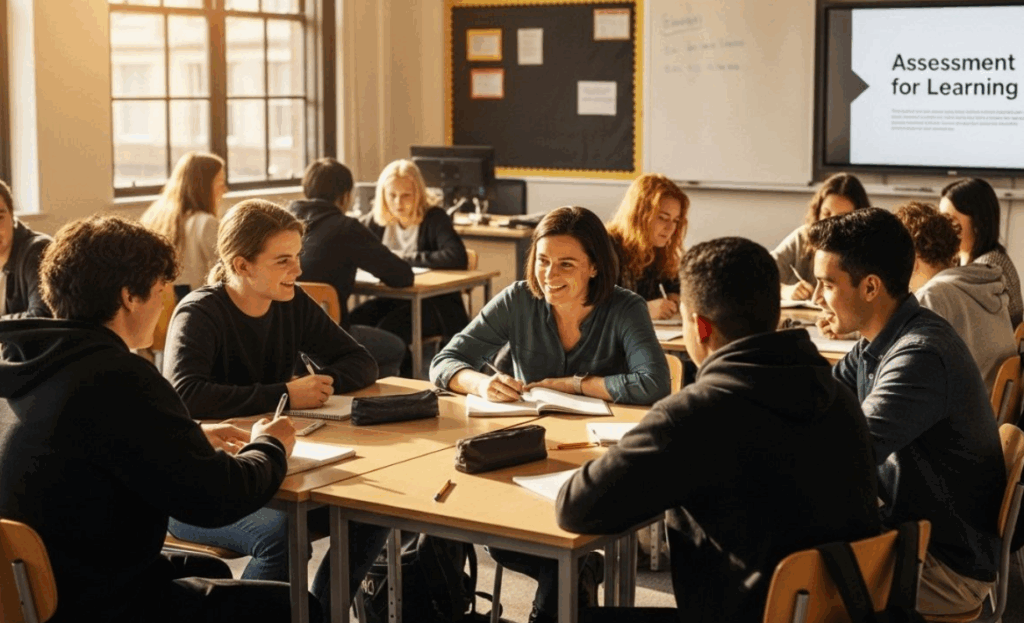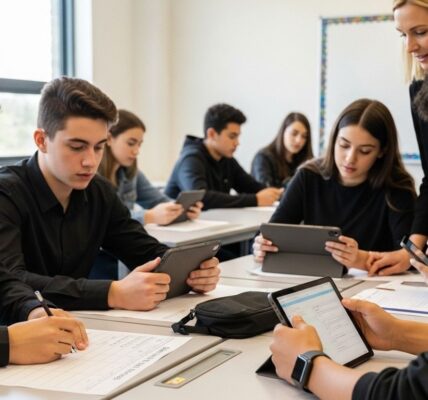Assessment for learning strategies are changing what it means to measure student progress. Traditional tests might show if a student gets the answer right or wrong, but that is just the surface. Schools using these strategies report up to a 30 percent increase in student engagement and depth of understanding. The catch is, this method is not just about grading. It flips the script so students actually shape their own learning journey.

Table of Contents
- Defining Assessment For Learning Strategies
- The Importance Of Assessment For Learning
- Key Concepts Of Assessment For Learning Strategies
- How Assessment For Learning Strategies Influence Teaching And Learning
- Real-World Applications Of Assessment For Learning Strategies
Quick Summary
| Takeaway | Explanation |
|---|---|
| Continuous feedback enhances learning | Regular, constructive feedback helps students understand their progress and guides their learning journey effectively. |
| Student involvement is crucial | Engaging students in their own learning promotes ownership and motivation, leading to better academic outcomes. |
| Adapt teaching based on student needs | Teachers should adjust instructional methods in real-time to address identified learning gaps and support individual progress. |
| Utilize diverse assessment methods | Incorporating varied assessment techniques, such as peer assessments and reflective journals, creates a richer learning environment. |
| Embrace technology in assessments | Technology can facilitate personalized feedback and adaptive learning experiences, improving student engagement and outcomes. |
Defining Assessment for Learning Strategies
Assessment for learning strategies represent an innovative educational approach that transforms traditional evaluation methods into dynamic, student-centered processes. Unlike conventional assessment techniques that merely measure student performance, these strategies focus on using assessment as a powerful tool for enhancing learning and understanding.
Core Principles of Assessment for Learning
At its foundation, assessment for learning strategies operate on critical principles that prioritize continuous improvement and active student engagement. These strategies are not about ranking or labeling students, but about providing meaningful feedback that guides their learning journey. Our comprehensive guide on student learning techniques can offer additional insights into complementary educational approaches.
Key characteristics of these strategies include:
- Involving students actively in understanding their own learning progress
- Creating opportunities for continuous feedback and reflection
- Adapting teaching methods based on real-time student performance insights
The table below summarizes the core features and key components of assessment for learning strategies, grouping critical aspects mentioned throughout the article for easy comparison and understanding.
| Core Feature / Component | Description |
|---|---|
| Continuous Feedback | Students receive regular, constructive feedback to guide their learning. |
| Student Involvement | Encourages active participation and ownership in the learning process. |
| Adaptable Instruction | Teachers adjust teaching based on real-time student performance insights. |
| Diverse Assessment Methods | Includes quizzes, peer reviews, journals, and portfolios for richer data. |
| Clear Learning Objectives | Students understand expectations and success criteria upfront. |
| Ongoing Evidence Collection | Progress is tracked continuously, not just at the end of a unit. |
| Technology Integration | Digital tools enhance feedback and allow for adaptive learning experiences. |
| Targeted Support and Intervention | Enables timely help and interventions based on individual student needs. |
Theoretical Framework and Implementation
According to research from MIT’s Teaching + Learning Lab, assessment for learning strategies are grounded in constructivist learning theory. This approach recognizes that learning is an active, dynamic process where students construct understanding through experiences and interactions.
The implementation of these strategies requires educators to shift from a traditional evaluation mindset to a collaborative learning approach. Teachers become facilitators who design assessment experiences that not only measure knowledge but also stimulate further learning and critical thinking. This means moving beyond standardized tests and embracing diverse assessment methods like:
- Interactive classroom discussions
- Self and peer assessment exercises
- Portfolio-based evaluations
- Reflective learning journals
By integrating these strategies, educational institutions can create more responsive, engaging, and personalized learning environments that empower students to take ownership of their educational journey.

The Importance of Assessment for Learning
Assessment for learning strategies represent a transformative approach in education that goes far beyond traditional evaluation methods. These strategies are crucial in creating a more dynamic, responsive, and student-centered learning environment that supports continuous academic growth and development.
The following table compares traditional assessment methods with assessment for learning strategies, highlighting the primary distinctions identified within the content.
| Aspect | Traditional Assessment | Assessment for Learning Strategies |
|---|---|---|
| Main Purpose | Measure and rank performance | Enhance learning and foster improvement |
| Feedback | Limited and delayed | Immediate and constructive |
| Student Role | Passive recipient | Active participant |
| Assessment Methods | Standardized tests | Diverse (peer review, journals, portfolios) |
| Teacher Response | Static instruction | Adaptive and responsive |
| Use of Technology | Minimal | Integrated (digital platforms, adaptive) |
Empowering Student Learning and Engagement
The significance of assessment for learning lies in its ability to shift the educational paradigm from passive measurement to active learning. Explore more about effective student learning techniques to understand how these strategies enhance educational experiences.
Key benefits of this approach include:
- Providing immediate and constructive feedback
- Encouraging student self-reflection and metacognition
- Creating personalized learning pathways
- Developing students’ critical thinking skills
Bridging Teaching and Learning Processes
According to research from the Oregon Department of Education, assessment for learning serves as a critical bridge between teaching and learning processes. This approach transforms assessment from a mere evaluation tool into a dynamic instrument for educational improvement.
The strategic implementation of these assessment strategies enables educators to:
- Diagnose student learning gaps in real time
- Adapt instructional methods to meet individual student needs
- Monitor student progress continuously
- Provide targeted support and intervention
By recognizing assessment as an integral part of the learning process, educational institutions can create more responsive and effective learning environments that support every student’s unique educational journey.
Key Concepts of Assessment for Learning Strategies
Assessment for learning strategies represent a sophisticated educational framework that goes beyond traditional evaluation methods. These strategies are rooted in a holistic approach to understanding student learning, emphasizing continuous improvement and personalized educational experiences. Learn more about effective learning techniques to complement these assessment strategies.
Fundamental Principles of Assessment
The core principles of assessment for learning are built on a dynamic understanding of educational progress. Unlike summative assessments that merely record student performance, these strategies focus on the ongoing process of learning and development.
Key foundational principles include:

- Viewing assessment as a continuous learning process
- Emphasizing student involvement in their own learning journey
- Creating a feedback-rich educational environment
- Recognizing individual learning differences
Strategic Implementation and Core Components
According to research from the Oregon Department of Education, effective assessment for learning strategies involve a comprehensive approach to understanding student progress. These strategies are characterized by several critical components:
- Establishing clear learning objectives and success criteria
- Developing methods for ongoing evidence collection
- Creating opportunities for student self-assessment
- Providing targeted and constructive feedback
- Encouraging student reflection and metacognition
By integrating these components, educators can transform assessment from a passive measurement tool into an active learning mechanism that supports student growth, encourages critical thinking, and promotes a more engaged and personalized learning experience.
How Assessment for Learning Strategies Influence Teaching and Learning
Assessment for learning strategies fundamentally transform the educational landscape by creating a dynamic, responsive relationship between teaching methodologies and student learning experiences. These strategies represent a paradigm shift from traditional assessment approaches, enabling more personalized and adaptive educational interactions. Discover effective student learning approaches to complement these innovative assessment techniques.
Transforming Instructional Approaches
At the core of assessment for learning strategies is the ability to reshape how educators understand and respond to student learning. These strategies provide real-time insights into student comprehension, allowing teachers to make immediate and targeted instructional adjustments.
Key transformative impacts include:
- Enabling data-driven instructional decision making
- Promoting responsive and adaptive teaching methods
- Identifying learning gaps more precisely
- Customizing learning experiences for individual student needs
Enhancing Student Learning Outcomes
According to research from the RAND Corporation, assessment for learning strategies significantly influence student achievement by creating a more interactive and personalized learning environment. These strategies empower students to become active participants in their own learning process, rather than passive recipients of information.
Critical mechanisms of influence involve:
- Providing continuous and constructive feedback
- Encouraging student self-reflection and metacognition
- Developing students’ capacity for independent learning
- Building students’ confidence and motivation
By integrating these strategies, educational institutions can create more responsive, engaging, and effective learning environments that support comprehensive student development and academic success.
Real-World Applications of Assessment for Learning Strategies
Assessment for learning strategies extend far beyond theoretical concepts, finding practical implementation across diverse educational settings. These strategies provide educators with powerful tools to enhance student learning, engagement, and academic performance. Explore innovative learning approaches to complement these assessment techniques.
Classroom Implementation Methods
In contemporary educational environments, assessment for learning strategies are being integrated through multiple practical approaches. Educators are transforming traditional teaching methods by creating dynamic, interactive learning experiences that prioritize student understanding and growth.
Practical classroom implementation techniques include:
- Interactive digital platforms for real-time student feedback
- Collaborative learning projects with embedded assessment components
- Periodic learning reflection journals
- Student-led assessment conferences
Technology-Enhanced Assessment Practices
According to research from Vanderbilt University’s Center for Teaching, technological innovations are revolutionizing assessment for learning strategies. Digital tools now enable more sophisticated, immediate, and personalized assessment techniques that were previously impossible.
Technology-driven assessment approaches encompass:
- Adaptive online learning platforms
- Machine learning algorithms for personalized learning paths
- Interactive quiz systems with immediate feedback
- Digital portfolios tracking student progress
By embracing these innovative strategies, educational institutions can create more responsive, engaging, and effective learning environments that support comprehensive student development and academic success.
Bring Assessment for Learning Strategies to Life With Ultra News
Are you struggling to turn assessment for learning theories into real results in your classroom or personal study routine? Understanding ongoing feedback, encouraging active reflection, and adapting to diverse learning needs are essential. Yet, with so much information out there, it is challenging to stay informed and apply the latest methods effectively. At Ultra News, we bridge this gap by providing timely educational resources and expert guides, giving you practical insights and up-to-date strategies for meaningful assessment and student success.

Start exploring our latest educational articles and actionable tools by visiting Ultra News. Dive deeper into our comprehensive guide on effective student learning techniques to gain practical advice you can use right away. Empower yourself or your students today—make your approach to assessment as dynamic as your desire to learn. Stay ahead by making Ultra News your trusted resource for both academic tips and the latest news updates.
Frequently Asked Questions
What are assessment for learning strategies?
Assessment for learning strategies are innovative educational approaches that transform traditional evaluations into dynamic, student-centered processes focused on enhancing learning and understanding rather than simply measuring student performance.
How do assessment for learning strategies benefit students?
These strategies provide immediate and constructive feedback, encourage self-reflection and metacognition, create personalized learning pathways, and develop critical thinking skills, ultimately fostering a more engaging learning environment.
What are some examples of assessment for learning techniques?
Examples include interactive classroom discussions, self and peer assessment exercises, portfolio-based evaluations, and reflective learning journals, all designed to promote continuous feedback and active student involvement.
How can teachers implement assessment for learning strategies effectively?
Teachers can effectively implement these strategies by establishing clear learning objectives, developing ongoing evidence collection methods, encouraging student self-assessment, and providing targeted feedback aimed at fostering student growth.




